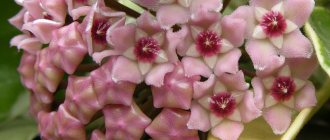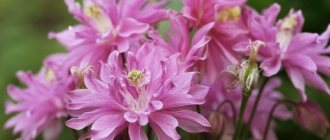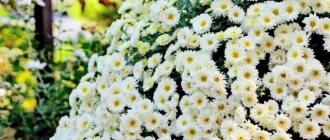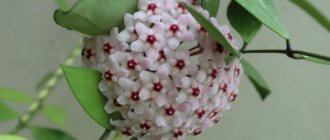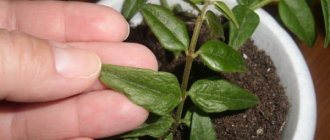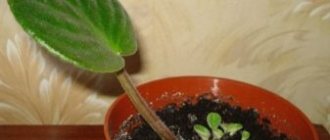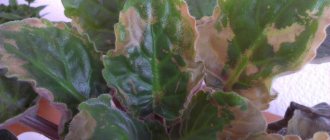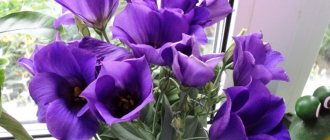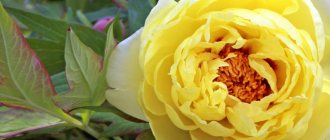Hoya lacunosa
Hoya lacunosa Blume, 1826 Hoya lacunosa (concave)
Habitat: warm forests of Malaysia, Indonesia and Thailand. In the wild state it is now also found in India, China, Singapore, Borneo and Sumatra. From history: in old botanical literature the name Otostemma lacunosum Blute (1848) is also found.
Description: H. lacunosa is an epiphytic growing hoya, in the environment it has a symbiotic relationship with ants that live among its roots and leaves. Small, dark green, diamond-shaped leaves with curved edges, which is how this species gets its name (lacuna - hollow). The reverse side of the sheet is shiny. The length of the leaves reaches 6 cm, width 1.5-2.5 cm. The new growth has a red-brown color. The leafy vines grow in a dense cascade and, unlike many of the Hoya genus, do not climb on their own. The corolla of the flower is white and fleecy, the crown is white with a yellow center. The diameter of the flower is 0.5 cm. When the flowers appear, their petals do not bend immediately. Only after two days do they take on their unusual appearance. Flowers are collected in umbrellas of 15-20 pieces. They do not produce nectar and last for about 5 days. The main flowering time is May. Particularly impressive is the striking aroma of Lacunosa flowers (as well as those of its relatives: H. obscura and H. pusilla, with the same curled flower petals), reminiscent of the smell of perfume. If several umbrellas are opened at the same time, the smell fills the entire space of the room. Hoya researcher CMBurton identifies two varieties: H. lacunosa v. lacunosa - has dark green leaves, covered with silver spots, 5-12 cm long and 1.5-2 cm wide. The corolla and crown of the flower are white. H. lacunosa v. pallidiflora Hook f. (1861) – it has smaller leaves and white flowers. The homeland of this variety is Thailand and Malaysia. There is also a close relative, H. lacunosa aff. (aff. means “similar, similar” - this is what they write when they are not sure of the species.) It also has diamond-shaped leaves and blooms just as well.
Care tips Temperature: minimum winter temperature 10°C. In summer, in a shaded place it can withstand elevated temperatures, but subject to increased air humidity. Lighting: the plant must be kept in a bright place with shade from direct sunlight to avoid burns on the leaves. In the sun, the leaves acquire a beautiful bronze “tan”; with prolonged contact with the sun’s rays, unattractive yellow-brown spots can form on the leaves. Watering: since this hoya is an epiphyte, it needs a loose substrate and maintaining a constant level of humidity (but not dampness). Responds well to a warm shower and daily spraying with warm water. Features: Recommended for beginners, as it grows quickly and blooms quite easily. To make the composition beautiful, several cuttings of H. lacunosa can be planted in one pot.
Cultivars: Hoya lacunosa 'Tove' – creamy white spherical flowers with a yellow center (about 6 mm in diameter and more than 20 flowers in an umbel), miniature in appearance, the leaves take on a beet-like hue in the sun.
Hoya lacunosa 'Snow Caps' – has silvery leaves, 5 cm long and 2 cm wide. The flower corolla and crown are white (flower diameter 10 mm). Slightly slower growing than other varieties of H. lacunosa.
Varieties
Carnosa
Description - this species has dark green leaves, on which there are inclusions of white to silver shades. There are variegated varieties that may have multi-colored stripes in the center and along the edges of the leaf pulp. The inflorescence of the plant is collected in a cluster, which can have up to twenty flowers of white shades with red in the middle.
Features - Hoya flowers can secrete nectar so much that it can drip. This species also has a feature associated with daylight hours. By the evening, the aroma from flowers may be more intense than during the day or in the morning. The plant is also capable of forming new inflorescences directly on the old one.
You can watch a review of Hoya Carnose in this video:
Kerry
Description - this type of plant will most need additional support, since the leaves are quite large in diameter and can be half the size of an adult’s palm. This plant is also called “green heart” because the leaves are heart-shaped. There are also variegated varieties. The inflorescences are white and red.
Features - usually for Valentine's Day, hoya is sold in pots of one large leaf. If you take care of the leaf, water it or make a small greenhouse, then soon it will give roots and new shoots, and after a while it will grow into a large and beautiful vine.
You can watch a review of Hoya Kerry in this video:
Compacta
Description - this species is a variety of the Hoya carnosa species. The dark green leaves have a curled appearance and can therefore be associated with curled hair. There are varieties that have two-color leaves. Leaves grow on liana branches. The inflorescences are small and compact, as is clear from the name of the plant. They have a pale pink tint.
Features - the main feature is the type of foliage of this species. It is extremely rare to find such curled leaves as those of this plant.
You can watch a review of the Hoya Compact in this video:
Lacunosa
Description - this species is otherwise called “curved” because the leaves are slightly curved at the edges, it has dark green foliage with white specks. The inflorescences in the cluster are white, round, “hairy” with a small star in the middle, yellow to cream in color. This vine grows very quickly in length.
Features - the advantage of Lacunosa is the delicate aroma from the flowers, which can fill the entire space of the home.
Linearis
Description - the type of plant has intricately shaped leaves that look more like sharp needles. The foliage is gray-green in color with a small edge. The inflorescences are cluster-shaped, cream and white in color, with small fibers.
Features - emits an aroma that can be compared to the smell of vanilla or lily.
Multiflora
Description - Hoya multiflora, or as it is also called multi-flowered, grows in the form of a bush, unlike many other species that have an ampelous shape. The leaves are large and resemble the foliage of a coffee tree. Inflorescences in the form of a pointed large yellow star and a small, white one located in the center.
Features - the plant is very suitable for beginner gardeners, as it is quite unpretentious in care and can bloom all year round.
Obowata
Description - the plant has large, round leaves of a rich green color. The surface of the leaves is covered with silvery inclusions. The inflorescences are cluster-shaped with up to thirty small flowers of a soft pink hue for the large “star” and red-crimson for the small one.
Features - the aroma from flowering resembles the smell of a rose. The plant is easy to care for and blooms profusely. It can also be easily rooted.
Bella
Description - the leaves have an elongated shape similar to a rounded arrowhead of light green color. The inflorescences are small, with seven to nine flowers in a cluster. The color of the large “star” is white, and the small one is burgundy or crimson.
Features: long flowering time. Each “umbrella” of inflorescence can please the eye for more than a week.
Home care
Despite the fact that Hoya is a local resident of warm countries, it feels no less comfortable in a temperate climate.
The flower does not require care and is quite hardy, which is why its popularity is associated.
Choosing a location and lighting
For an indoor exotic, it is important to immediately decide on a permanent place of residence; rearrangements have a negative impact on it. Therefore, if the plant develops safely, it is better not to move
You should not take hoya out onto the terrace or balcony in warm weather.
Hoya tolerates shade very well, but if you want to achieve flowering, then you cannot do without lighting. It is preferable for an indoor flower to have diffused sunlight. It is better to choose window sills on the west side
In summer it is important to protect from the sun, otherwise drying out of the foliage cannot be avoided.
In the autumn-winter period, natural light is not enough, because daylight hours should last 12-15 hours. In this case, additional lighting is required, possibly a fluorescent lamp.
Temperature
During the active growing season, the temperature ranges between +17-22°C in summer. It is able to tolerate even higher temperatures; it only needs abundant watering and high air humidity. But in winter, the temperature should be lowered to +12-15°C; at this time, the indoor flower does not sleep, but does not grow either. The temperature may drop to +10°C, but not less.
Humidity
As already mentioned, the plant is universal; there is no need to create special parameters in the room.
It grows well even in low humidity. Water procedures will also be useful: spraying, warm shower. It is important that water does not get on the flowers, or water drops must be wiped off immediately, otherwise dark stains will remain. It is recommended to ventilate the room daily
Hoya is an unpretentious plant: if you don’t think about it often, don’t move it from place to place, water it and replant it rarely, then it will delight you with long and abundant flowering. This is why wax ivy can often be found in office premises; sometimes this vine entwines the entire wall with its shoots.
Watering
The young plant is watered approximately once every 2-3 days. The soil in the flowerpot should be moist, but not wet. But an older individual is moisturized less often. Hoya tolerates drought more easily, because with the slightest lack of moisture, the root system quickly begins to rot. In the cold season, the amount of moisture must be reduced. Once every 2 weeks - this watering will be enough.
For procedures, use soft, settled water, without impurities and salts. Preferably warm or room temperature.
Feeding and fertilizers
It is necessary to fertilize the soil for exotic plants during the active period, starting in March. The flower reacts well to nutritious organic fertilizers; it is enough to apply them once every 30 days. Mineral preparations are applied approximately 2 times a month.
As a rule, fertilizers for flowering plants or nutrient complexes are used. During the cold period, it is better to refuse fertilizing.
The soil
Hoya also has no complaints about its growing environment. A flower can and will grow in any soil. But the most suitable substrate for a tropical guest should be loose, light and fertile. No less important are the following qualities: breathability and moisture resistance. The flower is suitable for soil for indoor palm trees or orchids.
If you want to prepare the soil yourself, the following soil mixture composition is suitable:
- turf soil - 1 part;
- deciduous soil - 1 part;
- humus – 1 part;
- coarse sand – 1/2 part.
To avoid stagnation of liquid and rotting processes, there must certainly be a drainage layer at the bottom of the pot. The following is used as drainage:
- expanded clay;
- broken brick;
- pebbles;
- fine crushed stone.
Trimming
For branching, pinch the indoor flower after 4 leaves. New shoots grow from the root. Too long, lifeless, dry shoots are removed. Pruning for Hoya compact stimulates the appearance of new healthy shoots and also gives a neat shape to the crown.
Watch a video about how to care for hoya at home:
Wintering Galesia
Preparation of a young lily of the valley tree for wintering should begin in the fall. Regular watering and loosening the soil will better prepare for the cold period and saturate the roots with moisture. On the eve of cold weather, sanitary cleaning of the plant is repeated, removing all dry shoots. It is also better to cut off immature young branches immediately, because they will not be able to overwinter anyway. Preparation is completed by hilling the base of the bushes. But they begin direct shelter only when severe frosts begin: galesia is very afraid of damping off and early shelter can be disastrous for it.
The crown of the plant is wrapped for the winter with non-woven material or agrofibre, not too tight and dense, with holes for ventilation. As soon as the first snow falls, the lily of the valley tree needs to be trampled down, and throughout the winter it is better to continue tossing and trampling down the white blanket as much as possible.
Mature trees over 1.5 m in height are not covered, limited to hilling and classical preparation.
When grown in a container culture, galesia is removed with the arrival of the first cold snap, moving the containers to rooms with a temperature of 12 to 15 degrees.
What Hoya gracilis looks like: description and photo
Hoya gracilis is a representative of the evergreen tropical vines of the Kutrovaceae family. It grows in the foothills among sparse trees, the branches of which are used as supports. The Hoya genus is very diverse. The following types are popular in indoor floriculture:
- Matilda;
- Compact;
- Bella;
- Imperial;
- Beautiful.
The plants received their name in honor of the Duke of Northumberland's gardener, Thomas Hoy.
Hoya gracilis was first described at the end of the 19th century in the Philippines, at the same time it was brought to Europe and has since been grown in greenhouses and ordinary apartments.
Known among flower growers by the names:
- "Tropical";
- "Wax";
- "Graceful."
The strong, dense lashes of Hoya gracilis are covered with oval spotted leaves 5cm long, with a pubescent underside. The waterfall of the original leaves makes the hoya decorative at any time of the year, but during the flowering period it is simply magnificent. Flowers in the shape of red stars with a yellow center are collected in umbrella inflorescences of 15-25 pieces. With proper care, flowering continues from May to November and looks like this:
Botanical description and appearance of the plant
Hoya gracilis is a type of vine with powerful branches, oblong dense leaves with pointed tips of a light green hue with barely noticeable spots, 3-4 cm long. The stem has nodes from which 2-3 leaves grow, creating a dense mat. If the plant receives sunlight, the leaves acquire a pinkish tint, and the stains become more contrasting. The lower surface of the leaf is slightly pubescent.
Hoya flowers are collected in inflorescences and are very beautiful.
Reference. The inflorescences consist of two dozen or more flowers - in the shape of stars on long stalks. In the center of each flower there is another star, but of a brighter shade.
Gracilis is not the only type of hoya. On our website you can find useful information about such varieties of this plant as Matilda, Lacunosa, Compacta, Lobby, Bella, Obovata, Cumingiana, Macrophylla, Retuza and Vaieti.
Is it possible to keep hoya at home and the qualities of wax ivy
Many cultivars are grown indoors. This plant has decorative qualities and is often used for landscaping offices and offices. There are a large number of legends and superstitions regarding the issue of growing Hoya at home, many of which, oddly enough, contradict each other.
For example, according to one belief, this flower “expels” men from their homes (husband, sons). According to other legends, culture is able to pacify resentment and envy. Still other sources, when asked whether it is possible to keep hoya or wax ivy at home, say that this plant is a source of happiness in the family, so the ideal place for growing it is the marital bedroom.
Which version to take into account is an individual decision of the gardener. But whatever the choice, it will not cancel the fact that exotic flowers can captivate everyone with their beautiful color, even the most demanding florist.
Basic rules for caring for tropical ivy
Hoya pubicalix is an inhabitant of the tropics; it is in this climate that it grows well. And the closer the apartment conditions are to natural ones, the more comfortable the vine feels.
Temperature
Hoya pubicalix does not like heat; if the temperature rises for a long time to +25 degrees or higher, it gets sick. For germinating seed material and cuttings, the ideal indicator is +22 degrees, not lower.
Watering
It is recommended to water Hoya pubicalix regularly, taking into account the season. During the intense summer heat, it is necessary to irrigate the foliage of the plant with a spray bottle, which reduces the temperature and humidifies the dry air.
In the autumn-winter period, the frequency of watering is reduced; the flower is watered after the soil dries out.
Soft water is used, standing for two to three days. To soften it, you can use sphagnum moss, which is placed in a container of water.
Lighting
Hoya pubicalix is light-loving, but the lighting should be diffused. It is better to place a container with a vine, including a hanging one, on the western or eastern side of the home.
In summer, hoya should be provided with shading, since if direct sunlight falls on it during the midday heat, burns and pigmentation may remain on the leaves.
In winter, a tropical flower may suffer from lack of lighting and get sick. If it is not possible to keep it in a well-lit area, then it is advisable to provide an additional light source - special lamps.
Suitable soil
You can purchase a ready-made soil mixture designed for indoor succulent plants and cacti. It is moderately light and acidified. But, experienced gardeners prefer to prepare the soil themselves, adding other components to the finished composition. For 500 g of soil take:
- 250–300 g crushed bark;
- 50–60 g perlite or vermiculite;
- 100 g chopped sphagnum moss;
- 100 g each of charcoal and coconut substrate.
A layer of drainage is placed at the bottom of the pot; pieces of foam plastic can be used for hoi; this material does not allow moisture to retain.
Trimming
Not all varieties of Hoi tolerate this procedure as well as pubicalix. Of course, the vine is pruned only if necessary, in order to obtain cuttings for subsequent propagation or if the shoots have grown too long. Dried and damaged parts of the flower must also be removed. For pruning, use a sharp knife with a sterile blade.
Fertilizer application
For full growth and timely, regular flowering, hoya should be fed with minerals. A sure sign of a lack of nitrogenous substances in the soil is slower growth and yellowing of the foliage.
From March to the end of August, fertilizers are applied once every 2 weeks.
It is important to strictly follow the dosage; if you overfeed, the vine may die
Choosing a pot
Hoya pubicalix does not require spacious containers; even an adult liana needs a pot with a volume of 1-1.2 liters. Plastic, shallow tanks are suitable for her; the roots of the flower grow moderately
But it is important that the pot has holes to drain excess moisture. Reservoir replacement is infrequently required
To prevent the rhizome from being torn out of the ground under the weight of long shoots, it is advisable to provide supports for an overgrown vine.
Growing
Seeds
After the seeds have ripened, they are slightly dried and sown in a substrate to which pieces of burlap or felt and sfangum moss are added. Seeds should be sown no later than a year after they are collected, otherwise they will lose their viability. If the seeds are fresh, they can be planted at any time of the year.
When the seeds germinate (about a week), follow these steps:
- do not allow the substrate to dry out;
- do not over-moisten the soil;
- provide good lighting;
- treat with a fungicide (Bordeaux mixture) for prevention, but under no circumstances use preparations containing copper.
After about three months, healthy seedlings are transplanted into separate pots along with moss so as not to damage the roots.
Leaf
Before the leaf is rooted, it must be treated with a growth stimulator. Adenine sulfate or kinetin is used for this purpose. When propagating hoya with leaves, the pot chosen is cramped. You also need to feed it periodically.
This method is labor-intensive and may not always be successful.
Cuttings
Growing by cuttings is considered the most common method of propagating Hoya graceful.
If all favorable conditions are created (optimal humidity, suitable temperature), the root system will form very quickly. The stalk should have two nodes. Cuttings are rooted in two ways.
When rooting in water, the cuttings are treated with root hormone, the container is placed in a warm place and covered with film, creating greenhouse conditions. After two weeks, the first roots appear and the cutting can be transplanted into a small pot.
The cutting is planted in a solid substrate (perlite, sphagnum moss, peat tablet, vermiculite) after its edge is treated with powder, which accelerates root growth. It is necessary to maintain optimal humidity, allowing excess water to drain out, and spraying frequently.
Temperature
Taking into account that Hoya gracilis naturally grows in mountain forests, it is necessary to create similar conditions for it indoors: it should be cool (up to 22 degrees) and humid. The plant does not tolerate temperatures above 30 degrees.
Watering the plant
You need to be very careful with watering and not over-moisten the soil. The next watering should be only after the top layer of soil has dried. Hoya gracilis loves spraying, which helps increase air humidity. Abundant spraying can sometimes replace watering.
Lighting. Hoya graceful loves bright, diffused light. In the morning or afternoon, the sun's rays will not harm it, therefore, the eastern or western side is suitable for it. Thanks to the sun's rays, the hoya leaves will acquire a pinkish tint and a spotted color.
Trimming. To form a beautiful crown, the plant can be pinched after the fourth leaf appears. Long shoots should be pruned - this will stimulate flowering. Threads are used as support for the stems, which are fixed to a window or wall. Sometimes a wire ring is used, but in order to prevent the plant from turning over, the pot must be heavy.
Feeding. It is necessary to feed Hoya with fertilizers twice a month throughout the entire growing season, starting in March. In winter, the plant is not fed.
Pot. You need to choose a small pot for Hoya gracilis. It is necessary to transplant the plant into a larger pot only when its roots become cramped in a small pot.
Diseases and pests
All types of hoya are resistant to diseases and pests, but if the surrounding air is too dry, the plant can be affected by scale insects or spider mites. In this case, the flower must be treated with an insecticide, for example, actellik.
Problems that a flower may have
- Falling leaves. The soil is waterlogged, the flower is standing on a cold window, or in the heat it was watered with very cold water.
- Spots on leaves. Appear from lack of lighting or sunburn.
- Hoya does not bloom. This occurs when there is insufficient lighting or a very warm winter (a warm shower can be used for stimulation).
- Drying, curled and very light leaves. They may appear from bright sun (it is better to shade the plant).
- Fall of flower buds or flowers. Occurs when the air is too hot and dry.
- Growing slowly, the leaves have turned pale green. The plant does not receive enough nutrients or requires replanting.
The necessary conditions
By creating the right conditions for the plant, you can enjoy its flowering at any time of the year. Fragrant buds are formed in hoya only with proper care. In the absence of proper attention, the flower will live, but will lose its decorative leaves and stop flowering.
Humidity
Hoya is a succulent vine that can survive without moisture for a long time. Therefore, an artificial increase in this indicator for a flower is not necessary. Even at 30% humidity, the plant feels great and even blooms without problems.
On hot days, spray with settled water. The flower responds well to such an additional “shower”, producing new peduncles. The main thing is that water does not get on the open flowers.
The plant benefits from bathing in the rain at least once a year, but the procedure cannot be carried out during flowering.
Temperature
In summer, the temperature should be between +22-26 °C. Lianas are all thermophilic. Even heat below +30 °C will not cause them much discomfort. With timely watering, high temperatures are preferable to low temperatures for hoya. In winter, cold temperatures down to 10 °C and below will be disastrous.
This flower does not need a rest period as urgently as other indoor plants. At constant temperatures around +22 °C, hoya will always grow and bloom, regardless of the time of year.
Of course, it doesn’t interfere with the flower’s rest; to do this, you just need to lower the temperature and reduce watering to a minimum, but fulfilling this condition during the heating season is quite difficult.
Lighting
The plant needs a lot of light. Especially varieties with variegated leaves, to which Gracilis also belongs. With a lack of light, the leaves become dull, their colors become pale, and flowering suddenly stops.
The liana looks good in hanging flowerpots directly on windows, preferably south or southeast. The plant should not be rotated - hoya does not like changes in position relative to the sun. The flower will also be comfortable on the wall near the window.
Description
Hoya macrophylla (Hoya macrophylla) or Hoya large-leaved - in 1826, Dr. Karl Blume, while traveling in Indonesia and on the island of Java, discovered a plant corresponding to the genus Hoya. The plant found was named Hoya macrophylla Blume or large-leaved Hoya.
Hoya macrophylla is a vine. It grows by entwining its shoots around any vertical pillar. At home, a metal rod can serve as such a vertical. The leaves of Hoya macrophylla are large, smooth, and have visible veins. The leaf length can reach 15-24 centimeters and the width 4-11 centimeters.
The leaf shape is oval, the tips of the leaves are pointed. In addition, it is worth noting that Hoya is strikingly beautiful in appearance. Large dark green, fleshy leaves eventually acquire yellow strokes along the edges or in the middle, which decorates Hoya with a marvelous palette that is pleasing to the eye.
Macrophylla blooms with a spherical umbrella formed by inflorescences. The inflorescences are held on purple pedicels from 2 to 8 centimeters long. The corolla of the inflorescence is a five-pointed star of soft pink color, and the petals are soft in shape and beige.
Types of wax ivy
There are about fifty plant varieties in the family. Only a small number of them are cultivated.
Fleshy waxy hoya
When this vine grows to six meters, by this time its shoots become woody. It grows only along vertical supports. On the stems, which have already turned green, oval-shaped leaves are formed, very fleshy and dark green in color. Peduncles with umbrella inflorescences emerge from the leaf axils.
Each inflorescence contains up to 15 flowers. White or pink color of the petals. The flower shape is an asterisk. The crown has a wine tint. It blooms two, sometimes three times a year. Flowering usually occurs from June to October. This species has several varieties: variegated, minibel, tricolor, compact. They all differ in the color of the petals and the diameter of the leaves and flowers. And also the pubescence of the flowers.
Characteristics of the variety
Breeding history
In the greenhouse of the Belgian botanist Begine, Hoya Carnosa and Hoya Serpens bloomed nearby.
Outside their natural habitat, pollination is difficult. The Belgian developed an unusual pod on one of the flowers, which gave seeds to 2 new plants. One of the varieties was named after the Queen of Belgium, Mathilde.
The full name of the variety is hoya cv. Mathilde splash. Here cv. = cultivar indicates its hybrid origin. Silvery specks on the leaves, similar to drops of water, led to the addition of splash.
External parameters
The homeland of the Hoyaceae family is Southeast Asia and Australia. During the selection process, this ornamental plant became more compact.
In apartments where there is a shortage of space, Hoya struggles for life on the verticals. It can be cultivated on supports as a climbing plant or as a hanging plant. Hoya Mathilde splash has:
- stems up to 1.5 mm thick;
- oval leaves 3 cm long and 2 cm wide;
- flower umbrellas consisting of 15-20 flowers. The corolla of the flower is white or pale pink, 2 cm in diameter. The crown is white with a red center.
Hoya propagation by seeds and leaves at home
Hoya propagation by seeds at home is carried out using well-dried seed material in the year of its collection. The substrate can be prepared according to one of the above “recipes”. Shoots appear after 7 days.
To prevent the occurrence of fungal diseases, it is recommended to treat them with some preparation containing copper in accordance with the instructions on the package. After 90 days, the seedlings will already have several pairs of leaves - from this moment they can be transplanted into separate flowerpots.
Hoya propagation from leaves is considered the most difficult and lengthy process. It is recommended to take leaves of those plants that live in the natural environment. Therefore, breeders use this method. But amateur florists also have the opportunity to experiment with house plants. The leaf is planted in a loose substrate, maintaining an angle of 45 ̊. After 2-3 weeks, roots will appear. The problem with this propagation method is that a leaf that has taken root may not sprout for several years. To speed up this process, drop one drop of “Heteroauxin” onto the base of the leaf using a pipette.
Reproduction
At home, Hoya compact is bred in three main ways: seeds, cuttings and layering.
- The seed method is more theoretical; in practice, it is not used at home. Due to its ineffectiveness and productivity. It is quite rare for a plant to set seeds, and buying them is a problem. They are expensive and difficult to find. Also, seed material has a very short shelf life.
- Cuttings are considered the simplest and most effective propagation method. But it also has its pros and cons. Conditions do not always allow the shoot to take root, or the plant is sick or exhausted. Then, too, he will not be able to produce any offspring. On the other hand, the cutting method is simple to perform and even novice gardeners can do it. It is possible to get a new copy similar to the mother one. No cash investment required.
- Reproduction by stem layering. This option doesn't always work. The difficulty lies in the duration of the rooting process and the formation of a new root system. However, in general it gives good results and does not cause a lot of trouble.
If we take into account that hoya is such a universal flower that grows in almost any microclimate and does not require special care, it becomes clear why the flower is so in demand. Not to mention the spectacular appearance, which will create an unusual, cozy atmosphere in any room.
Purchase and adaptation
Hoya is most often sold in the form of rooted first-year cuttings. Their price ranges from 200 to 500 rubles. An adult plant, aged 3 or more years, will cost 2,500-3,000 rubles. The liana grows slowly, so even a three-year-old bush will look modest.
Hoya gracilis
It is necessary to adapt the flower after purchase. Even if bred by a local grower, it may be infected with a bacterial or viral infection, and may also contain insect eggs. Imported plants require long-term quarantine and mandatory transplantation into more suitable, pre-disinfected soil.
Having brought a flower into the house, you need to quarantine it and just observe it for 2-3 weeks.
If there are no signs of disease, then it is transplanted and placed in a permanent place. If it becomes clear that it is infected, it must first be cured and only then placed next to other plants.
Reproduction methods
Seeds
The most labor-intensive method of propagation, which requires the creation of almost ideal greenhouse conditions for active seed germination.
Technology:
- ripened seeds are dried and treated with growth stimulants;
- sow to a depth of about 1 cm in a substrate of soil and moss;
- the crops are covered with film or glass to create a greenhouse.
Plants grown from seeds bloom after 2-3 years from rooting.
Cuttings
Propagation by cuttings has a high percentage of rooting and is the easiest way to get a new plant.
Hoya curtisi
For cuttings, use old shoots up to 8 cm long, cut last season (in spring or canopy). They are cut at a distance of 2-3 cm below the location of the internode. They are rooted in a substrate for succulents or in sand, or placed in water, having previously treated the cut with a root former.
The shoots are covered with glass or polyethylene on top, creating greenhouse conditions. The optimal temperature is 20C-22C. After the roots have formed, they are transplanted into a permanent pot.
By layering
Hoya is able to quickly take down aerial roots.
Hoya curtisi photo
Reproduction technology:
- a cut is made on the stem;
- the layering is fixed with a small amount of soil or moss;
- As roots form, the shoot is cut off from the mother plant and planted in a separate container.
This method makes it possible to begin flowering a year after rooting, sometimes earlier.
Hoya Reproduction
Hoya can be propagated at home in several ways.
Propagation by seeds
Hoya seeds
Obtaining and planting seeds is quite a troublesome task. Hoya seeds are rarely found on sale, and it is extremely difficult to obtain full-fledged seeds at home - they practically do not ripen. This method is most often used by breeders in large greenhouses. We'll tell you how this happens theoretically. After flowering, Hoya produces seeds. Only ripened and well-dried seeds are suitable for planting. They quickly lose their viability, so they are planted as soon as possible, at least in the same year they were collected. Hoya seeds are sown in a mixture of soil and sphagnum moss. The greenhouse must be kept constantly moist (not wet or dry), in a bright, warm place. Ventilate. Good seeds will hatch soon, a week after planting. Seedlings grow slowly. To prevent fungal diseases, we recommend spraying Wax Ivy seedlings with Bordeaux mixture or any other copper-containing preparation in strict accordance with the instructions. In about three months the first leaves will appear. Then it will be possible to think about transplanting young flowers into separate pots.
If you managed to collect seeds from a blooming Hoya at home and grow your own specimen from them, you have something to be proud of!
Reproduction by layering
A fairly simple and effective method of propagation. The new plant will bloom in the first year. To do this, choose a vine so that it can be placed in another pot, next door, on loose, nutritious soil, always with the addition of peat. The shoot with the knot is secured in the substrate with a pin. At the rooting site, a small incision is made on the shoot. This place is generously covered with moss, watered a little, and covered with plastic wrap. Such a greenhouse will stand next to the mother pot in a warm, bright place until roots form and young leaves appear. When you decide that the young shoot is strong enough, the shoot can be cut and separated from the mother bush. Now you can plant the Hoya layer with roots in a pot of suitable size and place it in a permanent place.
Sometimes, a branch with a notch is not placed on the soil in another pot, but is simply wrapped first in damp moss, then in polyethylene and tied well with twine. The same greenhouse effect at the cut site will lead to the appearance of roots. After a certain time, the branch is cut off for planting in a separate pot.
Propagation by cuttings
Hoya cuttings
This method is even simpler than the previous one. All spring and autumn you can propagate Hoya by cuttings. Select an area on last year's shoot with three internodes and two to three pairs of leaves. Sprinkle the cut area on the branch with crushed coal or treat it with garden varnish.
This may be interesting: Decembrist (Schlumbergera, Rozhdestvennik, Zygocactus) - care, reproduction and disease
Root cuttings either in water or directly in a nutrient substrate.
Let’s say right away that to fully guarantee survival, we recommend rooting several cuttings at once.
To root Hoya in water, you can add part of an activated carbon tablet to the water to eliminate infection, as well as Kornevin or Epin to stimulate root formation. Take warm, settled water. It is permissible to cover the container with a plastic bag, which is opened slightly for ventilation from time to time. The roots should appear in two to three weeks. Wait until they get stronger and grow a little. Then the cuttings can be transplanted into their own pots and placed in the place allocated for the flower. Sometimes, for a more beautiful flower arrangement, several cuttings are planted in one pot at once. In this case, choose a slightly larger pot.
When rooting Hoya in the substrate, sections of cuttings are also treated with Kornevin or Epin. The substrate should consist of three parts soil and part perlite and fine expanded clay. Stick the cuttings into the substrate so that the first internode is covered with soil. Cover the container with the cuttings with polyethylene or other transparent material. Place in a warm, bright place. The temperature should not be lower than 22 degrees. In two to three weeks, new leaves should appear, which means rooting was successful. Keep in mind that Hoya grown from cuttings will not bloom until the fourth year.
Leaf propagation
Only some species of Hoya can be propagated by leaves. For example, the Kerry variety is propagated by planting a leaf by cutting in a substrate under a film. For other species of this plant, this is the most unpredictable reproduction option. By planting a leaf in the substrate, you are not guaranteed to get a new plant. The roots of the leaf will appear very soon, but further growth may not be observed for a long time.
Diseases and pests
All types of hoya are resistant to diseases and pests, but if the surrounding air is too dry, the plant can be affected by scale insects or spider mites. In this case, the flower must be treated with an insecticide, for example, actellik.
Important. The plant can also be affected by root nematode, so the soil for replanting must be steamed.
Problems that a flower may have
- Falling leaves. The soil is waterlogged, the flower is standing on a cold window, or in the heat it was watered with very cold water.
- Spots on leaves. Appear from lack of lighting or sunburn.
- Hoya does not bloom. This occurs when there is insufficient lighting or a very warm winter (a warm shower can be used for stimulation).
- Drying, curled and very light leaves. They may appear from bright sun (it is better to shade the plant).
- Fall of flower buds or flowers. Occurs when the air is too hot and dry.
- Growing slowly, the leaves have turned pale green. The plant does not receive enough nutrients or requires replanting.
Diseases
Powdery mildew remains the most common disease. It manifests itself in the form of a white coating that affects the leaves and stem. If the form of the disease is not advanced, you can use regular soap. In addition, when growing Hoya fleshy, the following problems may arise:
- Wrinkling of leaves and rotting of roots are the result of overwatering.
- Lack of flowering means a very warm winter or lack of light.
- Leaf spotting - excessive fertilization, use of cold water for irrigation.
You will find a detailed description and tips for caring for such types of Hoya as Lobby, Multiflora, Macrophylla, Retusa, Gracilis, Matilda, Lacunosa, Cumingiana and Obovata in separate articles on our website.
Possible difficulties
Hoya has a strong immune system, so it is practically not affected by plant diseases. Only in advanced cases does a fungus settle on it.
On hot days with dry air, plants can be attacked by pests (red spider mites, aphids, scale insects, nematodes, mealybugs). It is necessary to treat the stems and soil with an insecticide. It is very difficult to escape from nematodes. Most often, cuttings are taken from healthy parts of plants, and the rest of the growth is destroyed. The soil and pot are sterilized before planting.
A number of problems can be eliminated by changing the care of your hoya. Spots on the leaves appear when there is a lack, and sometimes too much light. Too slow growth, thin and depleted leaves indicate a lack of fertilizer. If the leaves turn yellow, it means the room is too hot.
Hoya usually blooms regularly and profusely without additional effort, but if this does not happen, the care of the plant should be corrected. He needs to choose a fairly tight pot. Wintering must be cool. A warm shower and immersing the pot in warm water for 1.5-2 hours helps stimulate budding. Once the buds have appeared, the plant cannot be moved.
Description of the plant
- The plant is a perennial. It can be either a shrub or a liana.
- The shoots of the plant are very flexible and fleshy. All species are characterized by the growth of the top with a purple smooth skin without leaves.
- After a certain time, the trunk begins to turn green and overgrow with leaves. With age, the stem will become woody. If there is high air humidity in the room, then aerial roots will form in the leaf sinuses.
- Along the entire shoot, oval leaves with pointed edges are formed on low petioles. When the leaves are young, they shine on top; over time, the shine goes away and the leaf becomes dull. The leaves are 6-9 cm long and 3-5 cm wide.
- Hoya blooms from June to October. Flowering is wavy. Each inflorescence may not wither for three weeks. A flower-bearing arrow without leaves is formed from the leaf axils.
- The inflorescences are umbellate, round or flat. The flowers are bisexual, their number per inflorescence depends on the variety. The flower is formed by five oval-shaped petals with sharp edges.
- The center of the flower is very unusual: in the middle there is a tiny crown of anthers that have grown together. The diameter of each flower is 1.5-2 cm. The color of the flowers can be cream, snow-white, purple and shades of red. The crown is always darker than the color of the petals.
- During flowering, a pleasant aroma reminiscent of perfume is exuded. The flowers contain a lot of nectar; during flowering it forms into a dense drop. When flowering has ended, the bud is not removed; it will enlarge over time and produce new buds.
Care
This type of hoya is quite unpretentious. Even novice gardeners can grow a vine and make it bloom. It is enough to follow a number of rules when caring for the plant.
Temperature
The optimal temperature for the development of hoya is 20-23 degrees.
The vine will survive a slight drop in air temperature, but an increase to 30 degrees can be disastrous for it.
Watering
Hoya is an ideal pet for forgetful gardeners. It easily tolerates short-term droughts, but excessive watering can cause the development of root rot. The liana responds well to heavy spraying, and sometimes watering can be replaced with cool rain.
Lighting
When the leaves of Hoya gracilis are exposed to sunlight, the spotted leaf pattern becomes brighter. The best choice of location for the plant is an east or west window.
Creeper formation
After four full leaves appear, the young plant can be pinched to form a compact bush. Trimming hoya shoots will stimulate more luxuriant and longer flowering. Supporting threads or wire structures are needed to support the vines.
Top dressing
During the flowering period, Hoya gracilis needs to be fertilized with complex fertilizers at least 2 times a month. In winter their use is not advisable.
